- Author Matthew Elmers [email protected].
- Public 2023-12-16 21:49.
- Last modified 2025-01-24 09:17.
Using the available opportunities and resources, the Republic of Belarus is currently re-equipping its armed forces. With the help of several foreign states, primarily Russia, the Belarusian military are mastering new weapons and equipment. In the near future, the armed forces of Belarus should receive a new weapon system, which is expected to seriously increase their strike potential. In the summer of this year, it is planned to transfer the first multiple launch rocket systems of the "Polonaise" type to the troops.
The first information about the development of a new Belarusian MLRS appeared relatively recently - in the spring of last year. The shape of this system soon became known. At the parade on May 9, 2015 in Minsk, self-propelled launchers and transport-loading vehicles of the new Polonez complex were shown for the first time. Soon there was some information about the new development. In particular, it became known that the Polonaise project is a joint development of the Belarusian and Chinese industries. In particular, China was initially responsible for the creation and production of the missile part. The chassis, in turn, were of Belarusian origin.
As reported by the Belarusian press, by the middle of last year, the first tests of the new MLRS were carried out. On June 16, 2015, the head of the State Military Industry of Belarus Sergei Gurulev reported to President Alexander Lukashenko on the successful completion of tests of the Polonez system. Due to the joint development, one of the proving grounds in China has become a platform for these checks. The details of the work were not disclosed, but this did not prevent the emergence of a number of assumptions. For example, there are forecasts about the imminent testing of "Polonez" at the Belarusian test sites.
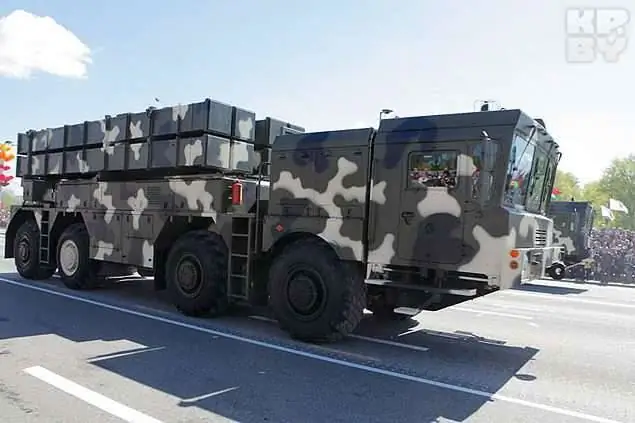
Self-propelled launcher MLRS "Polonez". Photo Kp.by
In early February 2016, the armed forces of Belarus held a rocket and artillery exercise. During the training and combat activities at the Polessky training ground, firing was performed from various weapons. According to some reports, during these exercises, the "Polonez" MLRS were also involved in the firing, which have not yet been officially adopted for service. Nevertheless, there was no official confirmation of such rumors, although representatives of the Belarusian command openly asserted that the new multiple launch rocket system should be tested at its ranges in the very near future. Based on the results of these checks, the complex can be put into service.
Recent reports on the further fate of the Polonez system suggest that the tests have already been carried out and the military decided to adopt it. In particular, last year it was argued that the first battery, armed with new multiple launch rocket systems, would enter service in early autumn 2016. Now the terms of acceptance into service have been shifted to July. It is possible that certain successes were achieved in the course of the inspections, which made it possible to adjust the plans in a positive sense of the word.
In contrast to some other data on the new Belarusian weapons, information about the approximate timing of the adoption of the "Polonez" was obtained from official sources. Thus, if in the future events develop without significant problems, then by the end of this summer, the missile forces and artillery of the neighboring state will master the new technology, which has a great advantage over the existing one.
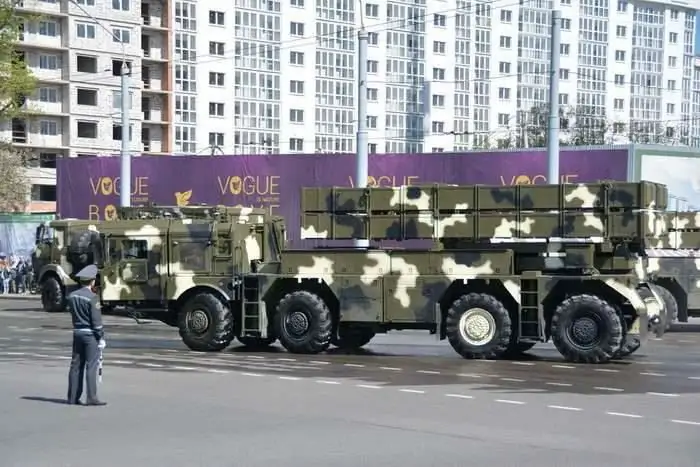
Launcher, side view. Photo Abw.by
According to available data, the "Polonez" MLRS project is a joint development of Belarusian and Chinese specialists. The industry of the Republic of Belarus was responsible for the production of basic automobile chassis and parts of the equipment installed on them. The People's Republic of China, in turn, was engaged in the development of missiles and related equipment. The result of this approach to development was the emergence of a new multiple launch rocket system, which, it is argued, differs from existing samples in high performance.
The new MLRS includes several main components. This is a self-propelled launcher, a transport-loading vehicle (TZM) and a new type of missile in a transport-launch container (TPK). In order to simplify operation and maintenance, all vehicles of the complex are built on the basis of the four-axle all-wheel drive chassis MZKT-7930 "Astrologer". This chassis is equipped with a 500 hp engine, which allows it to carry a payload of up to 24 tons and travel at speeds of up to 70 km / h. Thus, the selected chassis as a whole meets the requirements for the installation of launcher assemblies and ammunition transfer systems.
The unified chassis are equipped with platforms with a set of special equipment, the design of which partially uses the same units. In particular, outriggers are provided between the front and rear pairs of axles on both MLRS machines to stabilize the equipment during operation. The equipment of the platforms of the combat and transport-loading vehicles, in turn, differs due to different tasks being solved.
In the aft part of the platform of the self-propelled launcher, there is a lifting and turning device with attachments for transport and launch containers. This system is designed to guide the TPK missile package in the horizontal and vertical planes. In the stowed position, the package of containers is stacked along the platform. The launcher mounts carry eight missiles in their own containers. At the same time, two blocks of four TPKs are attached to the central lifting boom, to the right and left of it.
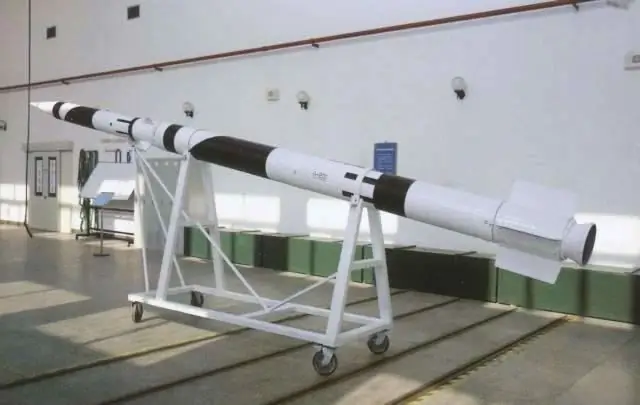
Rocket A200 Chinese design. Photo Bmpd.livejournal.com
TPM of the "Polonez" complex is equipped with a platform with other equipment. It provides fixed mounts for eight TPKs with missiles, behind which there is a crane. With the help of the latter, the calculation of the transport-loading vehicle must dismantle empty containers from the launcher and reload new TPKs in preparation for firing.
The most interesting element of the Polonaise multiple launch rocket system is a missile designed to engage various targets in a wide range of ranges. According to popular belief, the new Belarusian MLRS uses Chinese-designed A200 missiles, created by the First Academy or CALT (China Academy of Launch Vehicle Technology). This weapon has been offered for export for a long time and, it seems, has now found its buyer. Thus, the Chinese manufacturers of missile weapons managed to find a customer for their new development and conclude a lucrative contract.
According to reports, the A200 missile is a guided munition suitable for attacking targets over a relatively wide range of ranges. The rocket has a variable-caliber hull with a maximum diameter of 301 mm and a length of about 7.3 m. In the middle part of the hull there are X-shaped rudders, in the tail part there are stabilizers of a similar design. The maximum span of the planes (tail fins) reaches 615 mm. The weight of the product is declared at 750 kg. The missile can be equipped with three types of warheads. In the final phase of the flight, the warhead is separated from the rest of the rocket units.
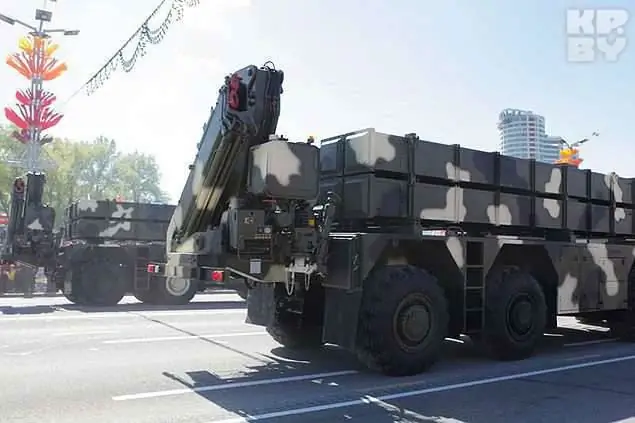
TPM with containers of missiles and a crane for their reloading. Photo Kp.by
One of the main objectives of the A200 project was to increase the firing range. According to published data, this weapon can fire at targets at ranges from 50 km. The maximum range is said to be in excess of 200 km. Due to the relatively long flight range, the missile is equipped with a guidance system. For control during flight, it is proposed to use an inertial guidance system with correction based on signals from satellite navigation systems. The CEP at the maximum range is declared at the level of 30-50 m. Some Belarusian sources mention an accuracy of up to several meters.
A200 missiles are delivered in square-section transport and launch containers. TPK are made sealed and intended for long-term storage of missiles. Before using the weapon, the containers are proposed to be installed on the launcher mounts and used as launch guides. Thus, after firing, the used container is dismantled, and a new one is installed in its place, after which the self-propelled launcher can fire again.
The announced information about the new MLRS "Polonez" is of great interest. The specialists of the two countries managed to successfully solve a number of important issues and create a multiple launch rocket system with very high characteristics, which favorably distinguish it from existing and promising foreign analogues. The most important advantage over other modern MLRS is the firing range of about (or at least) 200 km.
The most important features and advantages associated with a high firing range are fully revealed in the light of the peculiarities of the geography of Eastern Europe. In theory, such characteristics allow the Belarusian missile forces to target a large region, which includes significant territories of neighboring countries, which, for the most part, have strained relations with the Republic of Belarus. Thus, Minsk can get a very convenient and promising instrument that can significantly affect international relations in the region.
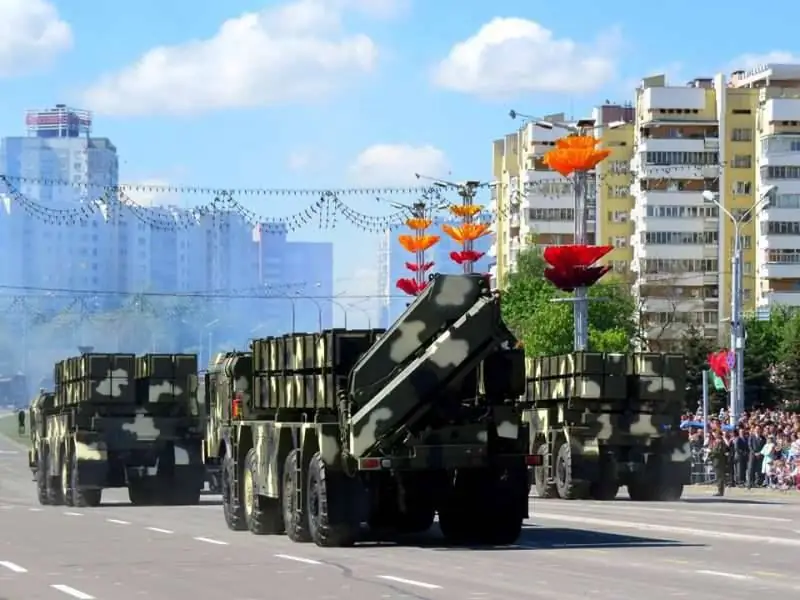
MLRS "Polonaise" at the parade. In the foreground are the TZM, in the distance are the launchers. Photo News.tut.by
Some Belarusian publications are already suggesting further improvement of the "Polonez" system. In particular, it is mentioned that with the help of foreign industry, Belarus can only receive missiles with a range of no more than 300 km. Further increase in the firing range, in accordance with existing international agreements, is possible only on our own. The successful solution of such a task by the forces of its own industry will additionally increase the strike potential of the missile forces, and will also have a corresponding effect on the international situation.
At the same time, Belarus may face a new specific problem. According to some reports, last year's tests in China were carried out due to the lack of appropriate test sites in the Belarusian territory. The ranges of the Republic of Belarus do not allow firing at a range of about 200 km. In addition, there is no opportunity to shoot from one training ground at training targets on another: the location of the Belarusian training grounds is such that the distance between some is less than the required 200 km, and between others is much greater. Thus, we will again have to look for an alternative site for testing with firing at the maximum range.
The Polonaise project has now gone through several important stages. In May last year, several samples of such a system were shown at a parade in Minsk. Shortly thereafter, the new weapon was tested at Chinese proving grounds. To date, the multiple launch rocket system has been checked by the Belarusian military, which resulted in preparations for its adoption. According to the latest data, the "Polygon" MLRS will be put into service this summer. The delivery of the first systems to the troops was postponed from September to July. Thus, in the very near future Belarus will receive new modern weapons that will increase the country's defense capability. Further growth in defense capability will be associated with the rate of serial production of new equipment. Any information about plans for the construction of new MLRS has not yet been published.






